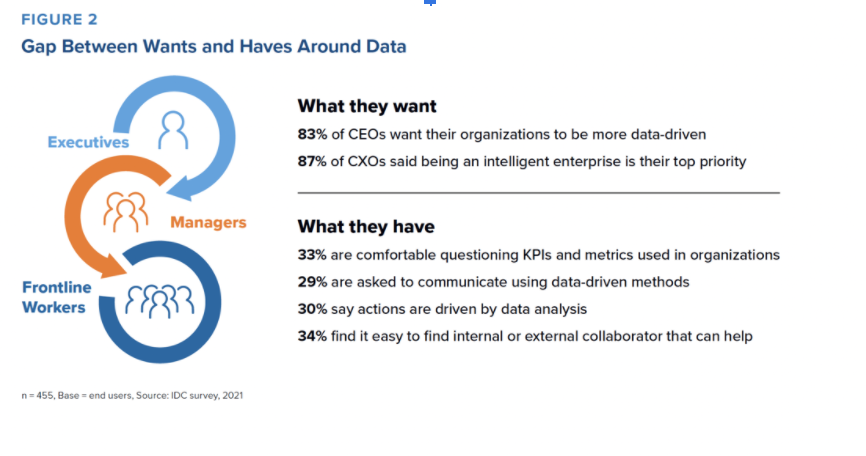
Executive Data Engagement and the Democratization of Analytics


What does it mean to democratize analytics? In essence, democratized analytics allows non-technical users to harness the power of AI and machine learning to make better decisions.
Recent research suggests that the need for these solutions is urgent. A new IDC study reveals that 83% of CEOs want their organizations to be more data-driven, but fewer than a third of employees say their day-to-day actions actually are driven by data analysis. This suggests incomplete implementation as well as some data culture issues:
- Companies don’t know how to scale data science core capabilities to satisfy the ever-increasing demand and time sensitive nature of decision-making
- Data science capabilities are not in the flow of where decisions are being made, from the C-Suite to the line-level employees
- The holy trinity of data culture – technology, people, and processes – is still immature.

Clearly, executives realize that data needs to play a larger part in how they do business, both for rapid and accurate decisions today and in planning for the future. But this realization should be tempered by the awareness that we can’t expect operational and frontline sales employees to suddenly become data practitioners. When the vision and the practice of data analytics aren’t aligned, you see gaps like the one IDC has uncovered.
More data power to the business
The good news is the technology around self-service analytics enablement has increased dramatically over the last few years. One example is Einstein Discovery, which leverages the power of AI and ML models that highlight what the projected business outcome is and identify specific actions to take to improve. This occurs directly within the workflow of an end user’s everyday activities, so they don’t have to ‘swivel chair’ to another application to do something – they can take action directly from the same view.
Even better, a sales leader doesn’t have to go to the data team and say, “Okay, so I have this list of leads. Who should I be prioritizing?” They’re able to offload that sort of prioritization burden to the platform, so they can focus their efforts on leads and opportunities that can drive positive business outcomes because the technology is enabling them to do that on the fly. That’s analytics at scale at work.
We’re also seeing the emergence of low-code and no-code platforms that don’t require highly specialized teams to administer, and that integrate natively within existing workflows to reduce disjointed user experiences. With low-code and no-code solutions you don’t have to know how to create a dashboard or build a complex machine learning model to understand propensity or recommendations. This is a great step forward as it offloads simple, high-level insight generation to technology platforms, allowing analytics practitioners the space to focus on the deep analytical work that requires precision and subject matter expertise.
Three ground rules for the democratization of analytics
Bringing data science capabilities to business domain experts enables organizations to execute faster and reduce wasted time and effort chasing things that won’t move the business forward. So what should data leaders be considering as they select and implement these solutions?
- Let humans have the final word. While technology built on machine learning and AI does much of the heavy lifting, there is still a need for human judgement and oversight. Data software is improving, but it’s still far from perfect.
- Examine the assumptions. Software coded with “objective” legacy data structures can bring forward stereotypes and inequalities without even realizing it. Even something as innocuous as a Zip Code can be freighted with outdated associations, so seek transparency in your solutions to generate ethical outcomes.
- Demand flexibility. Frontline end users rightfully point out that long lead times to get analytics solutions means that the conditions driving their needs may have changed, or that the assumptions they made in asking for solutions may not have been accurate. Your analytics solution must be able to generate outcomes quickly and allow for refinements on the fly.
On the whole, the outlook is bright. As long as we define and agree on roles and processes, establish the right methods for successful collaboration, and build in human touchpoints for ethical use and development of machine learning and AI, democratized analytics may emerge as one of the strongest data trends in years.






